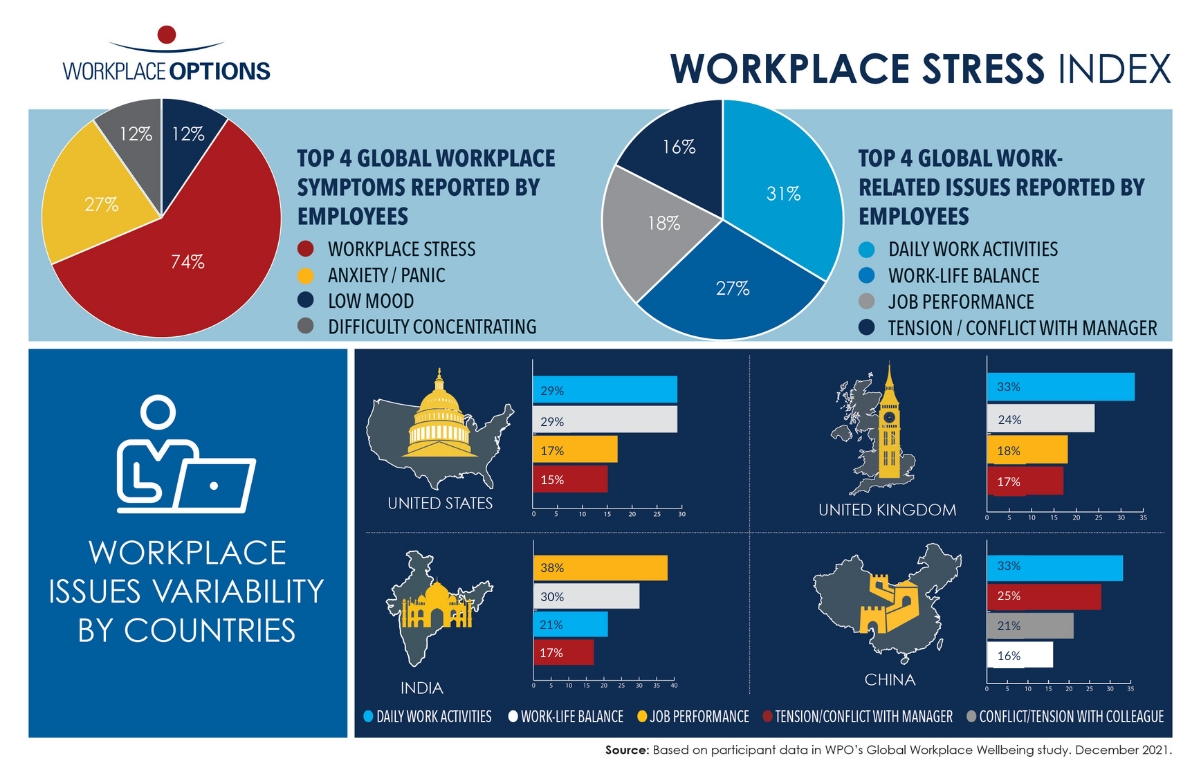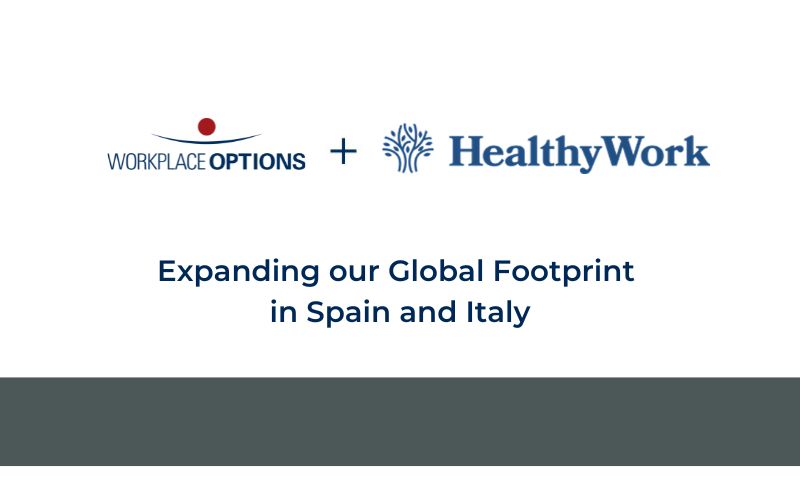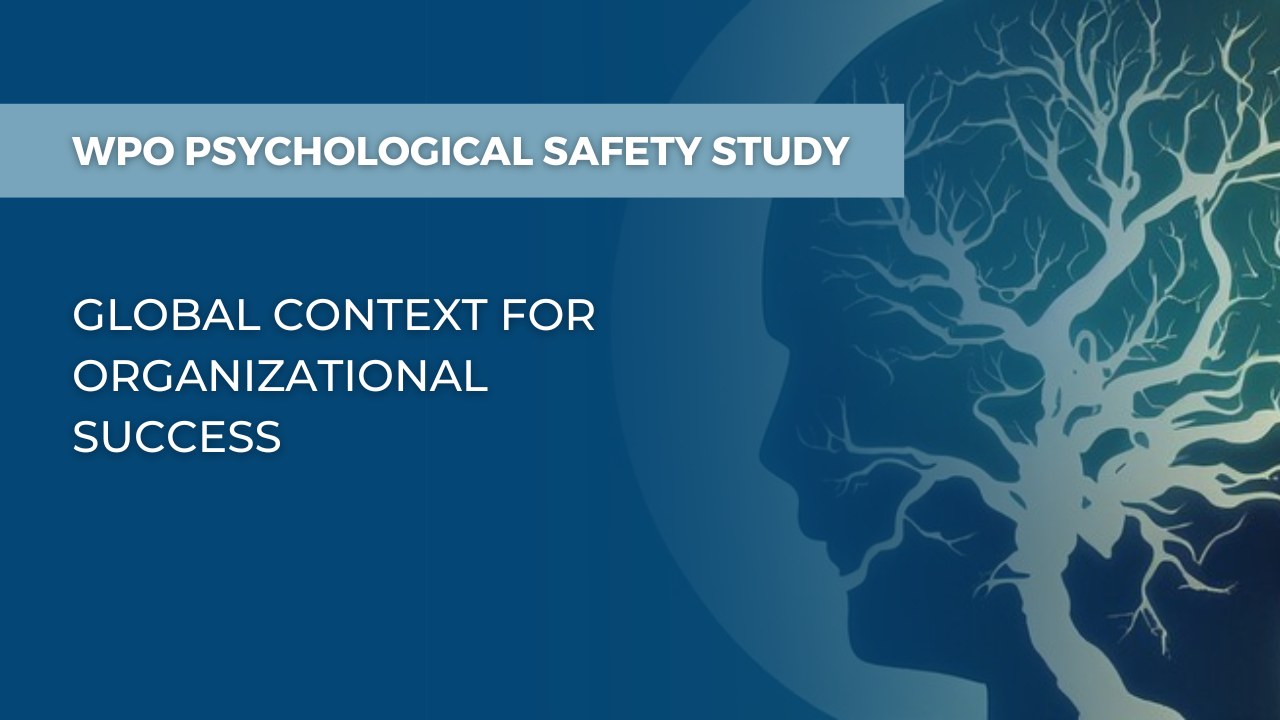Employees reaching out for emotional support for work-related concerns are most likely to cite problems with daily work activities, which include lack of autonomy, conflicting tasks, unclear objectives, and lack of clarity regarding their role and mission. This according to the global Workplace Stress Index released today by leading wellbeing provider Workplace Options (WPO). Poor work-life balance was the second most frequently reported issue by employees seeking help.

The WPO Workplace Stress Index represents WPO’s analysis of wellbeing data collected over the last nine months from more than seventeen thousand employees of small to Fortune 500 companies.
The Index identified stress (74 percent) followed by anxiety (27percent) as the leading symptoms self-reported by workers seeking emotional support.
“The workplace is experiencing a tremendous amount of disruption related to COVID-19, including supply chain issues, and workforce shortages,” shares Stephen Galliano, WPO’s Chief Customer Officer and a licensed clinical psychologist. “It is no surprise that employees are feeling somewhat lost and overwhelmed.”
Data provides important insight for employers
The Workplace Stress Index plays an important role in helping employers to identify and address potential areas for workplace health improvement.
“When stress is attributable to resolvable issues like role ambiguity or unclear objectives, there are immediate steps a manager can take to help rectify the situation” shares Galliano. “Even something simple like reviewing with an employee their key job functions and how their contributions support organizational objectives can have a big impact on engagement and emotional wellbeing.”
According to a recent article by WPO counselor James Sussex, feelings of stress are often indicative of a boundary having been violated. Since separating work from personal life can be a particular problem with remote and hybrid-work models, assisting employees with setting and maintaining boundaries is another way managers can help team members mitigate work-related stress.
While the Workplace Stress Index is released publicly on a biannual basis, WPO provides its clients with 24/7 access to anonymized and aggregated data via a dashboard. This tool gives clients the opportunity to compare their workforce needs to that of companies of similar sizes, industries, and regions.
“This can be transformational for organizations who are committed to prioritizing worker wellbeing,” shares Alan King, President and CEO of Workplace Options. “While protecting worker anonymity, the dashboard, which also trends concerns related to bullying and trauma, can alert leaders to red flags within their organization in nearly real time.”
Regional differences identified
The WPO Workplace Stress Index ranks the top four global work-related issues, as referenced by employees, as follows:
- Daily work activities (31 percent)
- Work-life balance (27 percent)
- Job performance (18 percent)
- Tension/conflict with manager (16 percent)
When looking at specific regions, there are some variations. For example, in India job performance (38 percent) was the most frequently identified workplace issue. In China, conflict or tension with a manager (25 percent) and conflict or tension with a colleague (21 percent) were the second and third most reported problems following concerns with daily work (33 percent).
Within the regional data, WPO’s found consistencies with the Hofstede Model’s Power Distance Index (PDI). Countries with a higher PDI, like China, are culturally more accepting of power inequalities, which could explain why employees in China are more likely to cite frustrations with a manager (25 percent) or colleague (21 percent) when seeking the assistance of a counselor. However, in the UK, which ranks lower on the PDI scale, frustrations with a manager or a colleague were cited less frequently, at 17 percent and 10 percent respectively.
Index to be used to identify trends
WPO’s Workplace Stress Index also includes a silver lining. The data showed that in the majority of cases when employees reached out for emotional support, their commitment to their employer had not waivered. Fifty-two percent reported that they were highly committed to their organization and 35 percent said that they were moderately committed. This is one of several data points that WPO will track to identify potential workplace trends.
“The Index will play an important role in 2022 and beyond to help organizations identify and respond to workforce needs in timely and practical ways,” shares King. “The speed of change in today’s workplace continues to accelerate. The data captured in this index allows us to keep up with the impact of these changes on employee wellbeing.”
About Workplace Options
Workplace Options is the world’s largest independent wellbeing solutions leader that supports individuals to become healthier, happier and more productive, both personally and professionally. We deliver digital and in-person support through tailored programs, data intelligence and a comprehensive global network of credentialed providers and professionals to deliver the best positive human-centered experience.
To learn more, visit www.workplaceoptions.com.






































